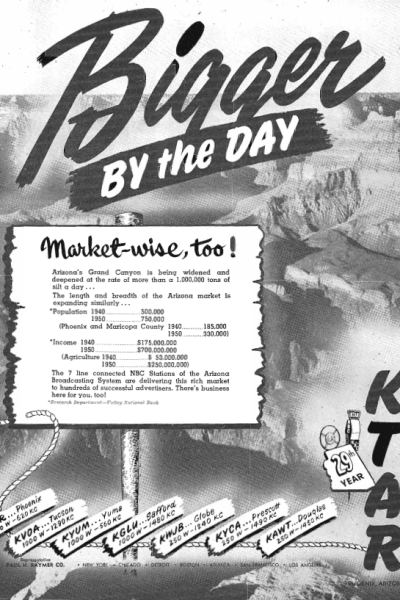Blog
The Advent of Radio Broadcasting in Northern Arizona
The history of radio in Northern Arizona is a fascinating narrative of technological innovation and cultural development, highlighting how communication and entertainment evolved in this region. The first documented commercial radio station in Northern Arizona emerged in the early 20th century, setting a precedent for the region’s media landscape.


Early Beginnings
The initial foray into radio broadcasting in Arizona began with amateur radio activities. However, it wasn’t until 1921 that the state saw its first commercial radio station. In Phoenix, an amateur station partially operated by a young Barry Goldwater transitioned to a commercial license in 1922 under the call sign KFCB, later becoming KOY. This station, while not in Northern Arizona, set the stage for subsequent broadcasting developments throughout the state.
Northern Arizona's Radio Pioneer
The first radio station in Northern Arizona specifically dates back to 1948, when KNAU, now known as Arizona Public Radio, began broadcasting from Flagstaff. KNAU was initially established as a non-commercial educational station, focusing on serving the community with educational content, news, and cultural programming. This station was pivotal in bringing public radio to the region, fostering a connection between the university and the broader community.
Statistical Overview of Early Radio in Northern Arizona
Number of Stations: By the mid-20th century, Northern Arizona had only a handful of radio stations. KNAU was the first, but it wasn’t until later decades that more stations would join the airwaves.
Coverage: Initially, KNAU’s signal was limited to the immediate Flagstaff area, but expanded over time to reach much of Northern Arizona, providing a vital source of information and entertainment to more remote areas.
Programming: In its early days, KNAU focused significantly on educational content, reflecting its roots with Northern Arizona University. By the 1970s, the station had expanded its programming to include news, classical music, and community-oriented shows.
Impact and Evolution
The introduction of KNAU marked a significant milestone in Northern Arizona’s media history. It not only provided a platform for local voices, but also played a crucial role in emergency broadcasting, which was particularly important in an area prone to natural events like forest fires and snowstorms. The station’s commitment to public service has been a consistent theme, offering weather updates, emergency information, and community announcements.
Audience Growth: Over the years, the listenership of KNAU and subsequent stations in Northern Arizona has grown, paralleling the area’s population increase. From its inception, KNAU has seen a steady rise in audience, especially with the introduction of FM broadcasting, which provided clearer sound quality and broader coverage.
Technological Advances: The shift from AM to FM in the region allowed better sound quality and stereo broadcasting, significantly enhancing the listening experience and attracting a broader audience.
In conclusion the journey of radio in Northern Arizona began with KNAU in 1948, marking the start of an era where local voices could reach into the homes and lives of the community. This station’s establishment was not just about broadcasting music or news, it was about building community resilience, sharing cultural experiences, and providing education. As Northern Arizona continues to grow, the role of its radio stations remains vital, bridging distances with sound and information in a way that continues to resonate with the region’s diverse populace.
Featured News
Category
Have Question?
Radio advertising can be a dynamic tool for elevating your brand. By understanding your audience, crafting compelling messages, and leveraging local connections, you can significantly enhance your brand presence and drive engagement.
Yavapai Broadcasting, known as “My Radio Place,” is a prominent radio station network that serves the vibrant communities of Yavapai County, Arizona. With a commitment to delivering high-quality programming, Yavapai Broadcasting offers a diverse range of content that caters to various interests and tastes.
Navajo Mountain Fire Response Impacts Lake Powell
Glen Canyon National Recreation Area, Utah, Ariz. – The Bridge Creek Fire, which is burning on Navajo Mountain approximately 5 miles from Lake Powell and Glen Canyon National Recreation Area, is located on Navajo Nation lands and is approximately 800 acres in size. Aircraft supporting firefighters on the incident will be using Lake Powell to refill buckets and tanks to aid in the firefighting effort. The aircraft using Lake Powell will consist of helicopters and fixed-wing Super Scoopers (amphibious aircraft). Glen Canyon rangers will be providing vessel support during aircraft operations on the lake. Until further notice, boaters are advised to remain toward the south wall of the canyon and to avoid Oak Bay as they are traversing between Dangling Rope to Rainbow Bridge. Recreation in the main channel should be limited to transit only. Boaters need to monitor marine radio channel 16. A temporary flight restriction is also in place for public safety during aerial operations. The Bureau of Indian Affairs Navajo Region Fire Management, Navajo Division of Public Safety, and Navajo Division of Emergency Management are leading the fire response, with Glen Canyon National Recreation Area Park Rangers supporting the aviation operation within the recreation area. For more information on the Bridge Creek Fire, please visit the BIA-Navajo Region Facebook Page. For updates on conditions and potential impacts to recreation on Lake Powell, visit Glen Canyon Alerts. https://www.nps.gov/glca/planyourvisit/conditions.htm
Coconino County Expanding Stage 2 Fire Restrictions
Coconino County will expand fire restrictions in coordination with the Kaibab National Forest. Stage 2 restrictions will take effect on Wednesday, June 18, 2025, at 6:00 p.m. for all unincorporated areas within the boundaries of the Williams Ranger District. At this time, unincorporated areas surrounding the Tusayan and North Kaibab Ranger Districts will remain outside of fire restrictions. This expansion joins the Coconino National Forest, City of Flagstaff, City of Sedona, State Lands, and all surrounding unincorporated areas of Coconino County. Fire restrictions are implemented to help prevent human-caused fires and to limit the exposure of visitors during periods of potentially dangerous fire conditions. Decisions about fire restrictions are a collaborative effort with area land management entities and are based on a combination of carefully measured factors. Criteria used to determine when to implement restrictions include current and predicted weather, fuel moisture, fire activity levels, enduring drought, and available firefighting resources. During Stage 2 restrictions igniting, building, maintaining, or using a fire fueled by combustible materials such as wood, charcoal, briquettes, and/or coal is strictly prohibited. Using a device that is solely fueled by pressurized liquid petroleum or LPG fuels that can be turned on and off is allowed only in a developed site. Smoking is also prohibited, except within an enclosed vehicle or a developed site. Additional prohibitions include the use of internal combustion engines for common household-only activities, such as landscaping or property maintenance and repair unless they are equipped with a spark arresting device. Stage 2 also prohibits welding and/or the use of acetylene or other torch with an open flame. The use of tracer or incendiary rounds of ammunition or explosive targets is also strictly prohibited. A developed site is defined in the County’s Wildfire Defense Ordinance as an area that is barren or cleared of all overhead and surrounding vegetation and combustible materials within a 15 foot radius of the device. The public is reminded to always be extra cautious when recreating on public lands, regardless of restrictions. Violations could result in fines and/or jail time. For information on Coconino County’s Stage 1, 2, and 3 fire restrictions please visit: www.coconino.az.gov/firerestrictions.
Stage 2 Fire Restrictions on Williams Ranger District
Due to increased fire danger and for public safety, the Kaibab National Forest will implement Stage 2 fire restrictions on the Williams Ranger District beginning 6 p.m. Wednesday, June 18. Stage 2 fire restrictions prohibit the following: Building, maintaining, or using a fire, campfire, or stove fire, including charcoal, coal, and briquettes, even in developed recreation sites. This includes smudge pots, pellet grills, and wood stoves. The only exception is using a stove or grill that is solely fueled by pressurized liquid petroleum or pressurized liquid petroleum gas (LPG) fuels. Smoking (except within an enclosed vehicle or building, a developed recreation site, or while stopped in an area at least 3 feet in diameter that is barren or cleared of any flammable material). Blasting, welding, or operating any acetylene or other torch with an open flame. During the hours of 9 a.m. to 8 p.m., operating a generator, chainsaw or other equipment powered by an internal combustion engine for felling, bucking, skidding, processing, road building and woodcutting during industrial operations or firewood gathering capable of igniting a fire. An exception is allowed for operating generators with an approved spark arrestor in an area barren or cleared of all overhead and surrounding flammable materials within 3 feet of the generator. Restrictions and closures typically remain in effect until the area receives significant, widespread precipitation. For information on restrictions and other alerts on the Kaibab National Forest visit https://www.fs.usda.gov/r03/kaibab/alerts.
